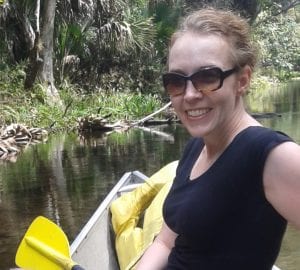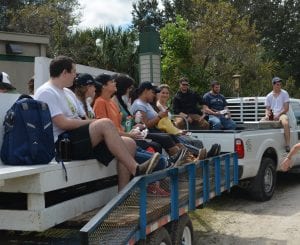UCF Lecturer’s Service-Learning Research is Cover of Academic Journal

Emily Heider on a water sampling trip. Courtesy of Emily Heider.
By Rachel Stamford
A UCF chemistry lecturer’s pioneering service-learning research on sucralose in the Orlando Easterly Wetlands has put her on the cover of a premier academic journal.
Dr. Emily Heider was a postdoctoral research assistant at the University of Central Florida developing sensors to detect mercury in water before she was hired in 2015 as a chemistry fundamentals lecturer at UCF. Heider believed water was such an important issue in chemistry that she was also a volunteer public tour guide with the Orlando Wetlands Park. As she taught the community how water is cleaned up before being sent to the St. John’s River, Heider had an epiphany to incorporate her interest in wetlands with students.
“When I thought about how many interesting analytical chemistry projects there were at the park, that’s when I wanted to get the students involved and help them realize how amazing the park was and also help the park managers answer the questions that they had,” Heider said. “It was kind of a good fit.”
Unlike most chemistry projects, Heider’s incorporated service-learning is a teaching method that connects classroom curriculum to an application that benefits the community. By allowing students to apply course concepts to real-world situations, service-learning increases students’ civic engagement and professional communication skills.

All the students in the CHM 3120 Lab on the field trip. Courtesy of Emily Heider.
Heider’s analytical chemistry lab transformed into a tangible wetlands project applying newly learned skills on real-world samples.
Students tested water in the Orlando Easterly Wetlands for sucralose, an artificial sweetener that indicates contamination by anthropogenic waste. The class designed a sampling strategy, then collected water to analyze its pH, chloride, total dissolved solids and phosphorous.
Heider’s study was the first of its kind not just because it involved service-learning, but because there has never been an analysis on sucralose in those wetlands performed before.
Soon after the service-learning project, it was accepted for publication in the Journal of Chemistry Education. The editor reached out to Heider and asked to publish her study for the cover of their January 2018 online edition. Heider had not planned on submitting her work as a feature article, so she was excited to see it was put on the cover. The story was also the cover for their April 2018 print edition.
Not much is known on sucralose’s long-term environmental impact besides it surfacing in diets and altering gut and intestinal bacteria. However, Heider’s research has caught the attention of the St. Johns River Water Management District for further studies.
As for Heider, she is looking towards the future of service-learning to engage more students.
Heider plans on working with the Brevard Museum of History and Natural Science and Orange County Regional History Center to incorporate service-learning projects that research museum content with STEM elements. She also expects her sucralose service-learning project to produce more research as time goes on.
“What’s cool about [the project] is that it sort of sets a benchmark that says, ‘Okay, in this year there was this much sucralose in this location’ and we’re finding it in more and more places,” Heider said. “We can also measure if it’s increasing and go from there.”
To read Heider’s research on sucralose, click here.
